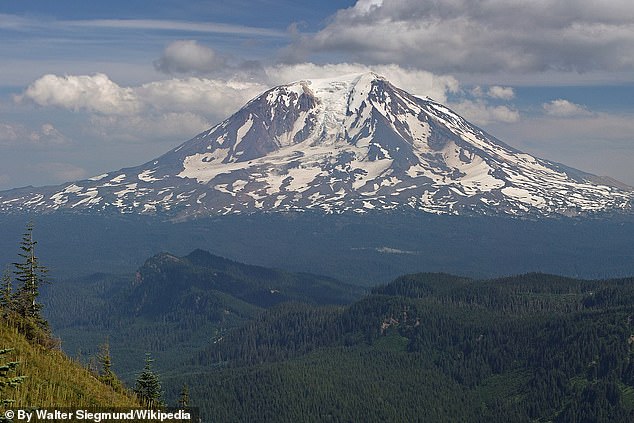Is Washington’s ‘high threat’ volcano about to explode? Scientists baffled by record spike in earthquakes around Mount Adams

Scientists are baffled by a record spike in earthquakes near Washington’s Mount Adams that has been dormant for thousands of years.
The volcano is considered a ‘major threat’ due to its ability to cause landslides, debris avalanches and mudslides that can travel up to 80 kilometers per hour down the slope, putting thousands of people at risk.
The region typically experiences earthquakes once every three years, but the US Geological Survey (USGS) detected six in September, with magnitudes ranging from 0.9 to 2.0.
Although very weak, previous studies have suggested that swarms of small earthquakes can precede a volcanic eruption.

Scientists have recorded a large increase in earthquakes around the most active volcano in Washington state: Mount Adams volcano
Earthquakes near Mount Adams typically occur only once every two to three years, and this the highest number of earthquakes to occur in one month since scientists began recording earthquakes in the area in 1982.
All six earthquakes were recorded at a seismic station seven miles southwest of the summit of Mount Adams, located southwest in the Gifford Pinchot National Forest, and at other stations much farther away from the volcano.
Scientists from the Cascades Volcano Observatory (CVO) and Pacific Northwest Seismic Network (PNSN) plan to install a series of temporary seismic stations around Mount Adams to investigate the size, location and depth of the earthquakes, the USGS said.
‘This will improve our ability to locate smaller earthquakes with more certainty and help us understand the cause of these earthquakes. The results of our findings will determine whether additional actions are necessary,” USGS officials wrote in a statement.
In some cases, earthquakes near volcanoes can cause eruptions.
But this only happens if the earthquake is large (greater than magnitude 6) and the volcano is already about to erupt.
When these conditions are met, the earthquake can cause dissolved gases to emerge from the magma, much like a shaken soda bottle, increasing pressure inside the volcano and leading to an eruption.
But these six earthquakes were far too small to cause an eruption.
And the USGS said there is no immediate threat of eruption.
Therefore, this increase in seismic activity is not a sign that Mount Adams is about to explode, USGS officials said.
Mount Adams was formed about 520,000 years ago. It is located approximately 70 miles northeast of Vancouver, Washington and Portland, Oregon.

The biggest threat to people living near this volcano are lahars, or muddy flows of rock, ash and ice, like the one that destroyed this Columbia town after a volcanic eruption in 1985.
Even though Mount Adams is considered a “high hazard” volcano, it hasn’t erupted in thousands of years.
Scientists estimate that the most recent eruption occurred sometime between 3,800 and 7,600 years ago.
And throughout history, Mount Adams has mainly produced effusive eruptions, which are distinguished from explosive eruptions in that they do not shoot lava, gas and ash into the air, but rather form slow-moving lava flows that creep up the sides of the volcano.
But the biggest threat to people living near this volcano is not an eruption.
According to the USGS, they are actually avalanches, landslides and lahars, or muddy flows of rock, ash and ice that “flow downstream like fast-flowing concrete” and can occur during eruptive or non-eruptive periods.
“The ice-capped summit conceals large amounts of hydrothermally weakened rock, and future landslides of this weakened rock could generate distant lahars,” USGS officials wrote.
The new, temporary monitoring stations will allow scientists to collect more data on the seismic activity beneath Mount Adams, allowing them to detect smaller earthquakes and better understand what has caused the recent increase in activity.
“The results of our findings will determine whether additional actions are necessary,” USGS officials said.




